
A teaching platform community for innovation, entrepreneurship, and moral education is being developed in colleges and universities against the backdrop of a multimedia network. This platform will aid in the formation of a multi-subject collaborative education mechanism and the joint cultivation of innovative and entrepreneurial talents, thereby promoting the high-quality development of innovation and entrepreneurship education in colleges and universities. Given the widespread use of neural networks, we address the utility of this technology in cross-modal multimedia retrieval from the following three perspectives using a depth-limited Boltzmann machine pre-trained sparse neural network model. The integration of moral education into the teaching platform allows for the realisation of quantitative and qualitative evaluation from theory to practise. Experiments demonstrate that our model can perform significantly better than a single model’s baseline performance.
osupport the overall transformation of higher education, colleges and universities should further their teaching of innovation and entrepreneurship. Building a scientific and technical consortium with participation from big and medium-sized technology businesses, small and medium-sized enterprises, colleges, and universities would also help to boost the leading and leading role of innovative enterprises [1,2]. In order to carry out innovation and entrepreneurship education, foreign nations currently have experience developing communities based on the combination of production and education. For instance, American colleges and business firms collaborate to create the Innovation and Entrepreneurship Accelerator, a unique organisation that can coordinate the interaction between the university and the business and foster close cooperation between the two [3,4]. College instructors and students can empower instructors and students by participating in the innovation and entrepreneurship accelerator. Local colleges and universities are developing their programmes in innovation and entrepreneurship education in the context of the new era, which can also be seen as a key component of the national innovation-driven development strategy [5].
Currently, innovation and entrepreneurship education in local colleges and universities has advanced favourably thanks to the aggressive promotion of numerous national initiatives, but there are still some open issues that require attention. There is a lack of innovative and entrepreneurial project incubation platforms, there is a lack of integration between entrepreneurship education and professional education, etc. This theoretical and practical aspect of the integration of production and education means that it must follow the path of integrated development and common development with other elements, i.e., community development, in order to achieve practical results in innovation and entrepreneurship education in colleges and universities and fully play its role in the national innovation-driven development strategy [6,7]. Building a community of innovation, entrepreneurship, and education in nearby colleges and universities for the integration of industry and education is helpful for achieving the effective connection between the supply and demand of social talent training [8].
Even though the existing subspace learning-based cross-modal multimedia retrieval techniques have had some success, there are still numerous issues: Semantic information, a high-level abstract idea from human comprehension, is not used by unsupervised retrieval techniques, but it is crucial for enhancing Unsupervised approaches cannot adequately describe the high-level semantic connection of multimodal data due to the model’s strong class-discriminative capabilities; supervised retrieval methods, on the other hand, can increase retrieval accuracy without taking any unlabeled data into account [9]. Consequently, it is impossible to accurately model the global semantic structural information of multimodal data; To further increase retrieval accuracy, semi-supervised retrieval techniques make use of the latent semantic information in unlabeled material. But these techniques When different modal data are treated independently and combined in a way that is complementary to cross-media semantic analysis, retrieval accuracy can be increased [10]. The deep neural network can be thought of as a multi-layer nonlinear projection, which is different from a single projection matrix. In addition, the traditional cross-modal multimedia retrieval method based on subspace learning uses a pair of projection matrices to project the underlying features of the image and text into the common subspace of the two [10].
The three primary contributions of this study are as follows:
Using deep learning to build a platform for instruction that integrates innovation, entrepreneurship, and moral education at colleges and institutions against a backdrop of multimedia networks.
This research investigates the use of neural network technology in cross-modal multimedia retrieval from three perspectives using a depth-restricted Boltzmann machine pre-trained sparse neural network model.
Research and analysis of the integrated teaching platform of innovation, entrepreneurship, and moral education at colleges and universities using our method has shown that it is effective and suitable, as demonstrated by experiments.
This section explains the cross-modal multimedia retrieval approach based on cooperative deep semantic learning, including implementation details and a detailed flow diagram [11]. Figure 1 displays the CR-CDSL frame diagram. First, utilising the features and semantic labels of the retrieved multimodal data, two complimentary deep neural network models are built and trained. The underlying characteristics of the picture and text samples are projected into their shared semantic representation space using the two network models. Create weak semantic labels for unlabeled images and text, then input the labelled training examples and the newly generated weak semantic labels into the neural network model to retrain the network.

Two complimentary deep neural network models are created through collaborative deep semantic learning in order to jointly produce weak semantic labels for unlabeled samples. The algorithm flow is as follows: First, initialize the predicted label vector matrix \(US\) of unlabeled examples as an all-zero matrix; second, Input all image and text underlying features and their label vector matrix \(LS\) and initialized \(US\) into two deep neural network models and start training; then, input unlabeled image samples \(UI\) and text samples \(UT\) into trained neural network models and obtain their top-level outputs \(IO\) and \(TO\); based on the computed \(IO\) and \(TO\) , the synergistic semantic representation \(US\) of unlabeled examples can be Eq. (1)
\[\label{e1} {S_U} = \left( {{O_I} – {O_T}} \right)*\left( {{O_I} – {O_T}} \right).\tag{1}\]
Export \(US\), and we get weak semantic markers for unlabeled examples. It is then processed as follows: first convert \(US\) into a probability distribution representation (as shown in Eq. (2)), then, for each column in it, set the maximum value of the elements in is to 1 and the rest to 0.
\[\label{e2} {p_{ij}} = \frac{{\exp \left( {{s_{ij}}} \right)}}{{\sum\limits_{k = 1}^c {\exp } \left( {{s_{ij}}} \right)}},{s_{ij}} = {p_{ij}}.\tag{2}\] With the newly generated weak semantic tokens, \(I\) and \(T\) and the updated S are input again into the deep neural network model and trained again. The above process of weak semantic token generation and retraining can be iterated multiple times. When the final iteration is over, the final outputs \(IO\) and \(TO\) of the deep neural network corresponding to the image and text, respectively, can be obtained, they are regarded as the final shared semantic space Now, the underlying features of the image and text have been projected to the common sub In space, the projection looks like this:
\[\label{e3} {M_I}:I_U^{u \times p} \to O_I^{\prime u \times c}.\tag{3}\]
\[\label{e4} {M_T}:T_U^{u \times q} \to O_T^{\prime u \times c}.\tag{4}\]
The similarity between picture samples and text samples can be directly assessed once the model obtains the common subspace of images and texts, and the samples that are most similar to the query samples are fed back to the user.
The output of the deep neural network model translates the underlying features of images and texts to the semantic space [12]. The underlying picture and text features serve as the input, and the semantic space serves as the output. As a result, the network model’s input layer’s number of neurons represents the dimension of the underlying features of texts and images, the output layer’s number of neurons represents the dimension of semantic space, and the hidden layer’s number of neurons is set to adhere to the principle of decreasing layer by layer. As a result, Figures 2, 3, 4 and 5 demonstrate, respectively, the topologies of the deep neural network models employed in the tests on the Wikipedia dataset, NUS-WIDE dataset, Wikipedia-CNN dataset, and INRIA-Web search-CNN dataset. The experiment trains an image network model with a structure of 128-70-30-10 on the Wikipedia dataset, and a text network model with a structure of 10-10-10-10 on the NUS-WIDE dataset. It also trains an image network model with a structure of 4096-1000-500-100-10 on the Wikipedia-CNN dataset, and a text network model with a structure of 100-50-20-10 on the Wikipedia-CNN dataset.

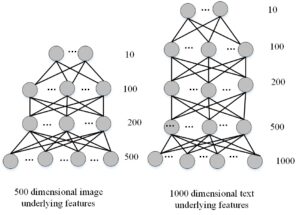
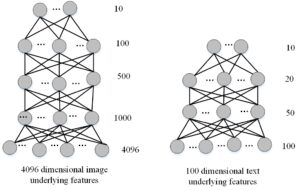
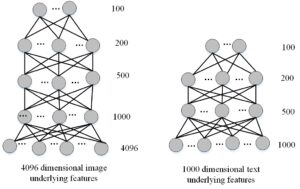
The underlying properties of the image and text are mapped to their shared semantic space before the image and text are mutually examined (as seen in Figure 6.
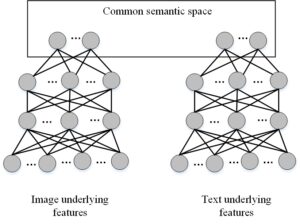
After projecting the underlying features of the image and text into the semantic space of the two, a query text is obtained, and the retrieval model can obtain its semantic representation \(\pi _T^k\), Most Relevant Images:
\[\label{e5} D(T,I) = \operatorname{dis} \tan ce\left( {\pi _T^k,\pi _I^k} \right).\tag{5}\]
Similarly, the same is true for image query related text. The cross-modal multimedia semantic matching algorithm based on deep neural network is shown in Table 1.
| Input | Train the underlying features and labels of images and texts, and test the underlying features of images and texts |
| Output | Cross modal multimedia retrieval results |
| 1) | Create image network \(N_1\) and text network \(N_T\) |
| 2) | Input the bottom features and marks of the training image into \(N_1\) and train the network, and input the bottom features and marks of the training text into \(N_T\) and train the network |
| 3) | Input the bottom features of the test image into the trained network \(N_1\), and input the bottom features of the test text into the trained network \(N_T\) |
| 4) | Obtain the top-level output of network \(N_1\) and \(N_T\), which is the common semantic space of image and text |
Centred Correlation, Normalised Correlation, KL (Libeler) divergence, L2, and L1 are some of the current distance functions used in cross-modal multimedia retrieval [13]. The experiment applies 5 distance functions to the Wikipedia dataset using the MRCR-RSNN approach, and the resulting MAP values are displayed in Table 2 to help determine which distance function is the most appropriate. The best outcomes are obtained at the CC distance. CC distance is therefore used as the distance metric function in subsequent studies.
| Method | Distance function | 12T | T21 | Avg |
|---|---|---|---|---|
| MRCR-RSNN | L1 | 21.74% | 21.03% | 21.39% |
| MRCR-RSNN | L2 | 20.72% | 21.17% | 20.95% |
| MRCR-RSNN | LKL | 22.33% | 21.32% | 21.81% |
| MRCR-RSNN | NC | 25.34% | 21.47% | 23.42% |
| MRCR-RSNN | CC | 30.02% | 21.35% | 25.69% |
On the Wikipedia dataset, NUS-WIDE dataset, and Wikipedia-CNN dataset, the tests compare the aforementioned approach with a number of different unsupervised cross-modal multimedia retrieval methods, and the retrieved MAP values are displayed in Table 3. According to experimental findings, MRCR-RSNN greatly enhances retrieval performance and produces superior results on the Wikipedia dataset, NUS-WIDE dataset, and Wikipedia-CNN dataset.
| Data set | Task | CCA | PLS | BLM | MRCR-NN | MRCR-SNN | MRCR-RSNN |
|---|---|---|---|---|---|---|---|
| Wikipedia | 12T | 18.23 | 23.76 | 25.63 | 26.54 | 28.12 | 30.02 |
| T21 | 20.93 | 17.24 | 18.36 | 19.37 | 20.19 | 21.35 | |
| Avg | 19.63 | 20.51 | 21.22 | 22.95 | 24.15 | 25.69 | |
| Nus-wide | 12t | 28.74 | 27.53 | 29.77 | 29.86 | 30.67 | 31.22 |
| T21 | 28.41 | 26.63 | 28.11 | 28.61 | 28.73 | 29.96 | |
| Avg | 28.57 | 27.08 | 28.96 | 28.94 | 29.25 | 29.72 | |
| Wikipedia-CNN | 12t | 22.63 | 25.06 | 26.63 | 30.82 | 32.72 | 34.22 |
| T21 | 24.64 | 25.24 | 26.63 | 27.36 | 29.21 | 31.93 | |
| Avg | 23.65 | 25.15 | 26.48 | 29.09 | 30.96 | 33.07 |
The Wikipedia dataset was created to address issues with cross-modal multimedia retrieval. Figure 7 illustrates how the mentioned methods—MRCR-NN, MRCR-SNN, and MRCR-RSNN—as well as unsupervised comparison techniques—CCA, PLS, and BLM—are used in the Histograms of MAP values for each class retrieved from the Wikipedia dataset for three different tasks of image retrieval text, text retrieval image, and average retrieval performance [14,15]. Figure 8 displays the retrieval precision-recall curves for both text and picture retrieval from the Wikipedia dataset using the aforementioned method and a comparison method. These findings demonstrate that the described methods outperform comparison methods in most semantic categories and precision-recall, with MRCR-RSNN having the best retrieval performance.
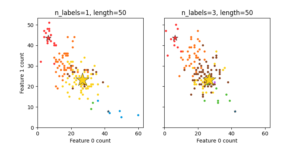

A lot of training examples are present in the NUS-WIDE dataset, which is used in experiments to assess retrieval performance. Similar to Figure 8 and 9 displays the methods MRCR-NN, MRCR-SNN, MRCR-RSNN as well as unsupervised comparison methods CCA and PLS for three distinct tasks: average retrieval performance, text-image retrieval, and picture retrieval. Each type of MAP value found in the NUS-WIDE dataset is represented by a BLM histogram. Figure 10 displays the retrieval accuracy-recall curves for both text and picture retrieval from the NUS-WIDE dataset using the aforementioned method and the comparison method. These findings demonstrate that, for the majority of semantic categories as well as precision-recall, the aforementioned methods outperform the comparison methods in terms of retrieval performance.

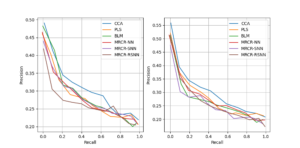
Convolutional Neural Networks (CNN), which can automatically extract image visual features without requiring human involvement, have recently been shown to have stronger feature representation in the field of computer vision [16]. Therefore, using the Wikipedia-CNN dataset, the trials will additionally test the aforementioned approaches. The Wikipedia-CNN dataset’s histograms of per-class MAP values for the three distinct tasks of extracting text from images, extracting images from text, and average retrieval performance for the aforementioned and comparable approaches are shown in Figure 11. Figure 12 displays the retrieval precision-recall curves for both text and picture retrieval from the Wikipedia-CNN dataset using the aforementioned method and a comparison method. The results once more demonstrate that, for the majority of semantic categories as well as precision-recall, the described methods outperform the competing methods in terms of retrieval performance.


In this study, a neural network-based cross-modal multimedia model for modal reconstruction is proposed. To translate the underlying image data into the text feature space, we employ a deep neural network model. In particular, the test images’ underlying features are fed into the trained network model after it has been trained using the training images and the text’s underlying features, and the network’s top-level output is then used as the text feature space. By doing this, the image’s underlying features are immediately projected into the feature space of the text, which is followed by the cross-media retrieval between the image and the text. In addition, we integrate the model with the university’s teaching platform for the integration of innovation, entrepreneurship, and moral education to achieve quantitative and qualitative evaluation from theory to practise.
There is no funding support for this study.